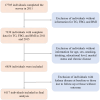Association between cumulative average triglyceride glucose-body mass index and the risk of CKD onset
- PMID: 40230478
- PMCID: PMC11994409
- DOI: 10.3389/fendo.2025.1525078
Association between cumulative average triglyceride glucose-body mass index and the risk of CKD onset
Abstract
Background: Chronic kidney disease (CKD) has become a significant global public health challenge, which was reported to be highly correlated with the triglyceride glucose-body mass index (TyG-BMI). Nevertheless, literature exploring the association between changes in the TyG-BMI and CKD incidence is scant, with most studies focusing on individual values of the TyG-BMI. We aimed to investigate whether cumulative average in the TyG-BMI were associated with CKD incidence.
Methods: Data in our study were obtained from the China Health and Retirement Longitudinal Study (CHARLS), which is an ongoing nationally representative prospective cohort study. The exposure was the cumulative average TyG-BMI from 2011 to 2015. The TyG-BMI was calculated by the formula ln [TG (mg/dl) × FBG (mg/dl)/2] × BMI (kg/m2), and the cumulative average TyG-BMI was calculated as follows: (TyG-BMI2011+ TyG-BMI2015)/2. Logistic regressions were used to determine the association between different quartiles of cumulative average TyG-BMI and CKD incidence. Meanwhile, restricted cubic spline was applied to examine the potential nonlinear association of the cumulative average TyG-BMI and CKD incidence. In addition, subgroup analysis was used to test the robustness of results.
Results: Of the 6117 participants (mean [SD] age at baseline, 58.64 [8.61] years), 2793 (45.7%) were men. During the 4 years of follow-up, 470 (7.7%) incident CKD cases were identified. After adjusting for potential confounders, compared to the participants in the lowest quartile of cumulative average TyG-BMI, participants in the 3rd and 4th quartile had a higher risk of CKD onset. The ORs and 95%CIs were [1.509(1.147, 1.990)] and [1.452(1.085, 1.948)] respectively. In addition, restricted cubic spline showed the cumulative average TyG-BMI had a liner association (p-nonlinear = 0.139).
Conclusions: The cumulative average in the TyG-BMI was independently associated with the risk of CKD in middle-aged and older adults. Monitoring long-term changes in the TyG-BMI may assist with the early identification of individuals at high risk of CKD.
Keywords: CHARLS; chronic kidney disease; cumulative change; old age; triglyceride glucose-body mass index.
Copyright © 2025 Wang, Chen, Zang and Hou.
Conflict of interest statement
The authors declare that the research was conducted in the absence of any commercial or financial relationships that could be construed as a potential conflict of interest.
Figures
Similar articles
-
Changes in the triglyceride glucose-body mass index estimate the risk of stroke in middle-aged and older Chinese adults: a nationwide prospective cohort study.Cardiovasc Diabetol. 2023 Sep 16;22(1):254. doi: 10.1186/s12933-023-01983-5. Cardiovasc Diabetol. 2023. PMID: 37716947 Free PMC article.
-
Association between the cumulative average triglyceride glucose-body mass index and cardiovascular disease incidence among the middle-aged and older population: a prospective nationwide cohort study in China.Cardiovasc Diabetol. 2024 Jan 6;23(1):16. doi: 10.1186/s12933-023-02114-w. Cardiovasc Diabetol. 2024. PMID: 38184577 Free PMC article.
-
Relationship between triglyceride glucose-body mass index baselines and variation with future cardiovascular diseases risk in the middle-aged and elderly individuals.Front Endocrinol (Lausanne). 2025 Jan 27;16:1514660. doi: 10.3389/fendo.2025.1514660. eCollection 2025. Front Endocrinol (Lausanne). 2025. PMID: 39931235 Free PMC article.
-
Elevated TyG-BMI index predicts incidence of chronic kidney disease.Clin Exp Med. 2024 Aug 28;24(1):203. doi: 10.1007/s10238-024-01472-3. Clin Exp Med. 2024. PMID: 39196406 Free PMC article.
-
Association of changes and cumulative measures of triglyceride-glucose index-body mass index with hypertension risk: a prospective cohort study.BMC Public Health. 2024 Sep 27;24(1):2652. doi: 10.1186/s12889-024-20154-z. BMC Public Health. 2024. PMID: 39334211 Free PMC article.
References
-
- Foreman KJ, Marquez N, Dolgert A, Fukutaki K, Fullman N, McGaughey M, et al. . Yuan CW et al: Forecasting life expectancy, years of life lost, and all-cause and cause-specific mortality for 250 causes of death: reference and alternative scenarios for 2016-40 for 195 countries and territories. Lancet. (2018) 392:2052–90. doi: 10.1016/S0140-6736(18)31694-5 - DOI - PMC - PubMed
-
- Liu T, Wu Y, Cao X, Yang K, Tong Y, Zhang F, et al. . Li Q et al: Association between sarcopenia and new-onset chronic kidney disease among middle-aged and elder adults: findings from the China Health and Retirement Longitudinal Study. BMC Geriatr. (2024) 24:134. doi: 10.1186/s12877-024-04691-1 - DOI - PMC - PubMed
MeSH terms
Substances
LinkOut - more resources
Full Text Sources
Medical
Miscellaneous




